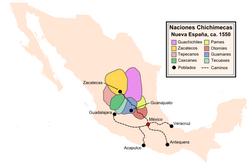This article has multiple issues. Please help improve it or discuss these issues on the talk page . (Learn how and when to remove these messages)
|
 Map of Zacateco and surrounding nations during the 16th century | |
| Total population | |
|---|---|
| Unknown | |
| Regions with significant populations | |
| Mexico (Zacatecas, Durango) | |
| Languages | |
| Spanish, formerly Zacateco (zꞌapa) [1] | |
| Religion | |
| Christianity especially Roman Catholic | |
| Related ethnic groups | |
| Caxcan, Guachichil, Guamare, Tepehuán, Pame, Tecuexe |
The Zacatecos (or Zacatecas) are an indigenous group, one of the peoples called Chichimecas by the Aztecs. They lived in most of what is now the state of Zacatecas and the northeastern part of Durango. They have many direct descendants, but most of their culture and traditions have disappeared with time. Large concentrations of modern-day descendants may reside in Zacatecas and Durango, as well as other large cities of Mexico.
